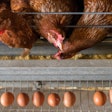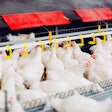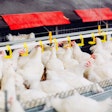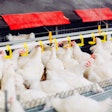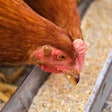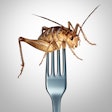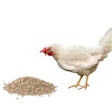Managing broiler intestinal integrity according to the season could see broiler flocks perform better and increase chicken producers’ bottom line.
Broiler gut integrity has long been thought to change according to the season, however findings presented at the Symposium on Gut Health in Production of Food Animals last year quantified the change in Northern European broiler performance that occurs between summer and winter.
Studies conducted across Germany, Poland, the Netherlands and the U.K. suggest that seasonality would appear to have an impact on the intestinal integrity of broilers, and that broiler producers’ economies may be improved by altering any intestinal protective strategies according to the season.
Multifactorial solutions
According to Dr. Alexandre Zocche, senior global technical consultant, poultry brands Elanco, the findings support the implementation of a multifactorial approach to promote better intestinal integrity protection, especially during the summer months.
The study concluded that producers need to set a special focus on intestinal and nutritional parameters, including diet viscosity and predisposing factors for the occurrence of subclinical necrotic enteritis. These factors can be diminished by adding a non-starch polysaccharides to poultry diets.
Summer months should also see the implementation of a good anticoccidial strategy, to better protect intestinal integrity and control the combined infections of Eimeria spp and Clostridium perfringens.

The summer months may see a decline in broiler performance due to an increase in problems with the gastrointestinal tract.
Cost of not acting
Seasonality was estimated to have an economic impact of EUR20 (US$21) per 1,000 kg of live bird weight for the three-year period, or the equivalent of EUR16,000 per year for every million broilers of 2.4 kg live weight.
The cost was calculated by applying the Intestinal Integrity Index, developed by Elanco Animal Health, to its Health Tracking System (HTS) during the summer – June-September – and the winter – October to May – between January 2012 and December 2014, and the study results indicate that the difference between the winter and summer groups resulted in a an improvement of 0.44 points for the winter period.
The cost of seasonality for broiler producers was estimated using differences in average live body weight, and comparisons of live body weight between winter and summer seasons revealed a difference of +22.04 g.
“The impact of seasonality on flocks’ intestinal integrity has long been a point of discussion in the industry, along with questions about how to effectively assess enteric health,” said Dr. Alexandre Zocche, senior global technical consultant, poultry brands, Elanco.
While the study proposed a number of strategy to help improve broiler performance during the summer, the researchers noted that more work needs to be done to better understand and evaluate broilers’ physiology and to identify which macroscopical gastrointestinal tract changes are more visible in the summer months.
Broiler gut health summer check list
- Follow an effective anticoccidial strategy
- Adopt a multifactorial approach to better intestinal integrity
- Factors predisposing subclinical necrotic enteritis should receive a special focus.
To learn more about intestinal health, read:
Good poultry gut health needs a broad approach







